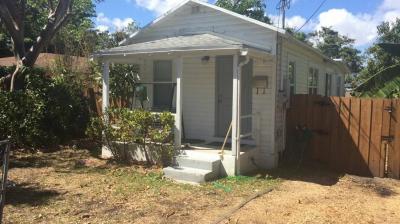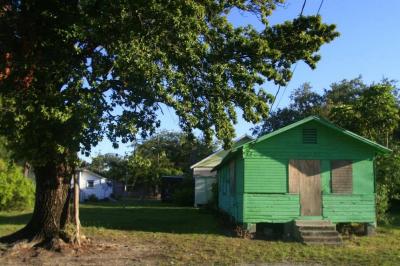
|
This neighborhood has 50 shotgun houses and wood homes. Are they historic landmarks?
BY ANDRES VIGLUCCI
Look carefully and you see standing remnants of the past scattered through west Coconut Grove. Now the shotgun houses and wood-frame cottages that were once ubiquitous in the historically black neighborhood are fast disappearing under a wave of redevelopment and gentrification.
The question facing this besieged, mostly poor community is this: Are these humble structures historic landmarks that should be saved?
 The city of Miami says, emphatically, yes. Its historic preservation office has identified some 50 wooden homes that could be designated as a historic collection. Protecting them, the office says, would help preserve the Bahamian and American Southern heritage of the West Grove, one of the city's oldest and most distinctive - but also most endangered - neighborhoods.
The city of Miami says, emphatically, yes. Its historic preservation office has identified some 50 wooden homes that could be designated as a historic collection. Protecting them, the office says, would help preserve the Bahamian and American Southern heritage of the West Grove, one of the city's oldest and most distinctive - but also most endangered - neighborhoods.
But the move has proven bitterly controversial in the West Grove. Though many in the community have been clamoring for the city to do something to slow gentrification, the preservation effort - intended as one of several public initiatives to do just that - has many property owners up in arms.
The reasons for the opposition vary as much as the race and place of residence of the objectors who include both longtime West Grove residents of Bahamian and black southern descent, and whites living in the neighborhood and outside of it.
Some objecting owners are investors or developers looking to demolish and replace the wood homes. Others treasure the homes and live in them or rent them out - but say they don't want burdensome new regulations. And some longtime owners worry that historic designation would make renovations more expensive or restrict their ability to sell down the road for the highest possible price, which likely means as a teardown.
 "I've been a good steward of those little houses and I've been good to my tenants," said Jean-Bernard Diederich, a real estate agent who has owned two 1930s shotgun-style duplexes on the city list for more than 16 years, in an interview. "But if they're going to tie my hands regarding the property, it becomes more complicated. Nobody's ever cared about these properties but me. But because I've done the right thing, they're looking to punish me. "
"I've been a good steward of those little houses and I've been good to my tenants," said Jean-Bernard Diederich, a real estate agent who has owned two 1930s shotgun-style duplexes on the city list for more than 16 years, in an interview. "But if they're going to tie my hands regarding the property, it becomes more complicated. Nobody's ever cared about these properties but me. But because I've done the right thing, they're looking to punish me. "
The designation idea has supporters, to be sure, including preservationists and Grove activists as well as owners of some houses on the city list. They note historic designation has helped revive neighborhoods as disparate as South Beach, Morningside and Biscayne Boulevard in northeast Miami. And they argue that protecting the houses from demolition could also help salvage the West Grove, where developers have been buying up and tearing down homes and apartment buildings, many of which had fallen into foreclosure, at a fast clip.
"If that architecture of the West Grove is gone, that history is gone," said Anthony Vinciguerra, a coordinator at St. Thomas University's Center for Community Engagement who owns and lives in a 1936 shotgun house on Charles Avenue that's up for designation. "Without designation, the historic residents of the West Grove are going to be pushed out even more rapidly."
But the historic designation question has become so heated that three public meetings hosted by the city were marked at times by loud voices and angry recriminations over the proposal.
To be designated as historic, a property must meet at least one of several criteria for architectural or historic significance. The houses up for possible designation were included because they likely meet the criteria, the preservation office said. Final determination is up to the board.
At the hearing, board members sought to dispel what they said were misconceptions and "misinformation" raised by some critics. Some, for instance, erroneously asserted that preservation constituted a back-door effort to turn out black residents by raising their property taxes, blocking them from selling entirely, or overburdening them financially by forcing them to restore the homes. Historic designation does none of that.
Designation by itself does not require owners to make repairs or change anything, though they would have to get approval from the preservation office to ensure any exterior renovations or additions they do undertake adhere to the houses' historic look.
By an 8-0 vote, the board gave the city preservation office a green light to proceed with an in-depth study on the designation proposal. That means that demolition of any of the houses on the list is barred for 120 days or until the board makes a final decision on designation.
Because some property owners complained they had not heard about the proposal or been notified of public meetings until recently, the board also instructed the city to host at least two other formal informational meetings to explain the ramifications of historic designation and receive feedback.
The designation plan comes as many homes in both the poor West Grove and the more affluent south, central and north portions of Coconut Grove are being demolished by developers who topple trees and build Modernist, lot-filling "white cubes" or townhouses that critics say don't conform to the neighborhoods' historic scale and look.
In the West Grove, rows of apartment buildings that provided inexpensive if substandard housing have been demolished, leaving vacant lots behind and pushing out hundreds of residents. New homes catering to affluent buyers are also starting to appear in the West Grove as long-established families sell or are forced out by foreclosures or financial straits.
In response, Miami Commissioner Ken Russell, who represents the Grove, has proposed a sharp tightening of the two special zoning districts that are meant to protect the area from inappropriate development. The commission also approved a proposal by Russell to have the city pursue a community redevelopment district for the West Grove in which property taxes generated from new development in the neighborhood would be reinvested within its boundaries.
And Russell also pushed the city to protect the remaining wood-frame homes that once characterized the neighborhood. Because the houses are scattered, it wasn't possible to create a unified historic district, like Morningside or South Beach. So the city commission approved an idea for the creation of "thematic" groups of designations that would cover a particular architectural style or type of construction. Such thematic designations have been used in other cities, including neighboring Coral Gables, which designated a scattered collection of century-old coral-rock homes.
The West Grove homes the city is now seeking to protect were built between 1911 and 1941 in a variety of styles originating in the American South and the Bahamas. Several are shotguns – long, narrow houses in which rooms are lined up front to back. The style may have originated in New Orleans.
The shotgun name is most commonly attributed to the idea that buckshot fired through the front door would go clear out the back door without hitting anything inside. The inexpensive houses, which also allowed air to flow through, were once common all across the South. Elvis Presley was born in one that's a museum today. The houses eventually were associated with poverty, but today are increasingly appreciated across the country for their scale, simplicity and historic value.
The idea of protecting the Grove's wood-frame homes is not new. The city designated a handful of individual homes built by neighborhood pioneers, including E.W. Stirrup. In 1994, Coral Gables created a historic district in the westernmost end of the West Grove, which falls within that suburb's boundaries. The tidy MacFarlane Homestead historic districtincludes a number of shotguns and other wood-frame houses.
The city is now helping low-income owners renovate two wooden homes that had fallen into disrepair with help of Miami-Dade County grants, said Gables preservation chief Dona Spain. She noted that such grants would be available to low-income homeowners in the Miami portion of the West Grove as well. Russell has also said a grant program could be set up as part of a new, voter-approved city of Miami bond program.
"It's super-important for the history of South Florida to have these wood-frame houses," Spain said. "I would urge the city to move forward with the idea."
But not everyone in the West Grove agrees. One owner of a house on the designation list said it has been condemned by the city as unsafe. Christ Episcopal Church, which owns numerous properties in the West Grove, had decided to replace one it owns with new affordable housing. Others say the cost of properly renovating a rundown wood-frame house would exceed the existing structure's value.
Still others say their homes have been in their family for generations, and argue it's unfair to prevent them from cashing out for a teardown if they decide to do so.
Diederich, who grew up in Haiti, said his pair of duplexes remind him of the Caribbean. He said he has spent a small fortune in maintenance and renovations and has no intention of tearing them down. But he said the rules that come along with designation would be a hassle and he doesn't want a government official telling him how his houses should look. And if one day he decides to sell, designation would make it harder because many buyers don't want the bother or the plain looks, either.
"This is simple, utilitarian rental housing that was built for workers," he said. "They're tough to sell. If the city wants them to look historically accurate, they're going to kill me."